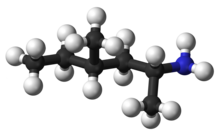1,3-二甲基戊胺
外觀
 | |
 | |
| 臨床資料 | |
|---|---|
| 其他名稱 | 1,3-二甲基戊胺 1,3-DMAA 二甲基戊胺 DMAA |
| 給藥途徑 | 鼻內噴劑、口服 |
| ATC碼 |
|
| 藥物動力學數據 | |
| 生物半衰期 | ~8.5小時 |
| 辨識資訊 | |
| CAS號 | 105-41-9 |
| PubChem CID | |
| ChemSpider | |
| UNII | |
| CompTox Dashboard (EPA) | |
| ECHA InfoCard | 100.002.997 |
| 化學資訊 | |
| 化學式 | C7H17N |
| 摩爾質素 | 115.22 g·mol−1 |
| 3D模型(JSmol) | |
| |
| |
甲基己胺(又稱1,3-二甲基戊胺、1,3-DMAA、二甲基戊胺和DMAA;商品名Forthane和Geranamine)是一種由禮來公司發明並研發的間接擬交感神經藥,自1948年以來作為一種吸入型鼻塞緩解劑投放市場,但於1970年代被停止銷售。[2]
自2006年以來,甲基己胺以許多名稱作為興奮劑或提高能量的補劑廣泛銷售,據說是因為它類似於老鸛草中的某些化合物,但因具有數個不良副作用而受到質疑,至少有五個死亡與含甲基己胺的補劑有關。[3]它被許多運動管理局和政府機構禁止。即使FDA已發出幾封警告信,[4]截至2019年,這種化合物仍出現於運動和減肥補劑中。[5]
參見
[編輯]參考文獻
[編輯]- ^ 1,3-Dimethylpentylamine - Compound Summary. PubChem Compound. USA: National Center for Biotechnology Information. Identification and Related Records. 26 March 2005 [27 May 2012]. (原始內容存檔於2014-03-01).
- ^ Cohen, Pieter A. DMAA as a Dietary Supplement Ingredient. Archives of Internal Medicine. 9 July 2012, 172 (13): 1038–9. PMID 22566490. doi:10.1001/archinternmed.2012.1677
 .
.
- ^ Singer, Natasha; Peter Lattman. F.D.A. Issues Warning on Workout Supplement. New York Times. April 16, 2013 [April 16, 2013]. (原始內容存檔於2019-01-03).
- ^ FDA, Center for Food Safety and Applied. Products & Ingredients - DMAA in Products Marketed as Dietary Supplements. FDA. May 2019 [2022-02-22]. (原始內容存檔於2019-04-23) (英語).
- ^ Cohen, Pieter A.; Wen, Anita; Gerona, Roy. Prohibited Stimulants in Dietary Supplements After Enforcement Action by the US Food and Drug Administration. JAMA Internal Medicine. 1 December 2018, 178 (12): 1721–1723. PMC 6583602
 . PMID 30422217. doi:10.1001/jamainternmed.2018.4846.
. PMID 30422217. doi:10.1001/jamainternmed.2018.4846.
外部連結
[編輯]- Stimulant Potentially Dangerous to Health, FDA Warns. U.S. Food and Drug Administration. April 11, 2013 [2022-02-22]. (原始內容存檔於2014-02-01).
- Bussel, Igor I; Pavlov Jr, Andrey A. DMAA: Efficacious but is it Safe?. Science Based Medicine Blog. June 7, 2013 [2022-02-22]. (原始內容存檔於2013-06-09).
